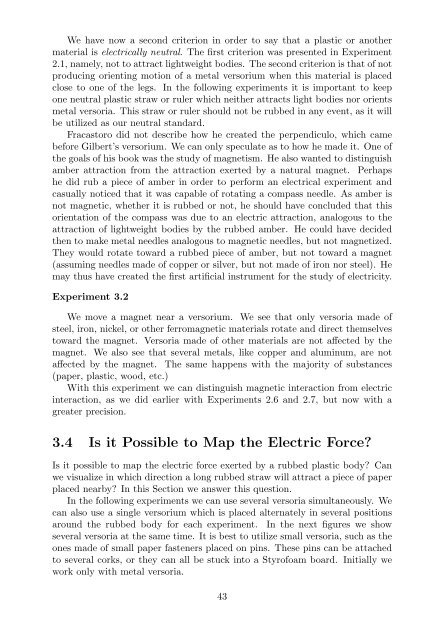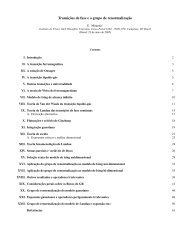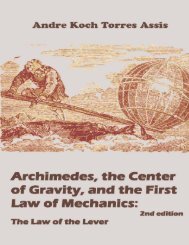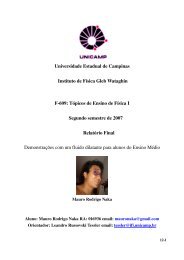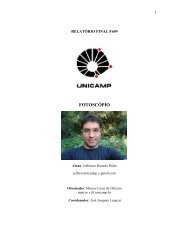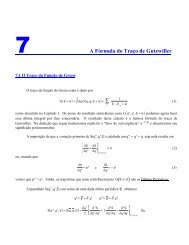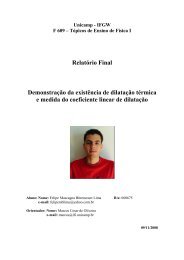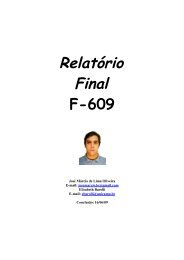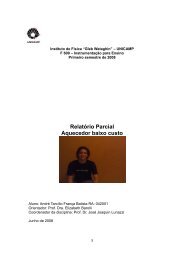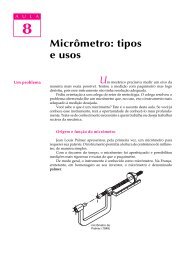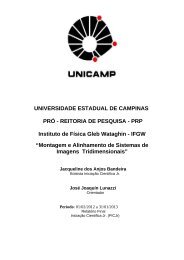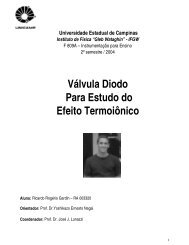The Experimental and Historical Foundations of Electricity - Unicamp
The Experimental and Historical Foundations of Electricity - Unicamp
The Experimental and Historical Foundations of Electricity - Unicamp
Create successful ePaper yourself
Turn your PDF publications into a flip-book with our unique Google optimized e-Paper software.
We have now a second criterion in order to say that a plastic or another<br />
material is electrically neutral. <strong>The</strong> first criterion was presented in Experiment<br />
2.1, namely, nottoattractlightweightbodies. <strong>The</strong>secondcriterionisthat<strong>of</strong>not<br />
producing orienting motion <strong>of</strong> a metal versorium when this material is placed<br />
close to one <strong>of</strong> the legs. In the following experiments it is important to keep<br />
one neutral plastic straw or ruler which neither attracts light bodies nor orients<br />
metal versoria. This straw or ruler should not be rubbed in any event, as it will<br />
be utilized as our neutral st<strong>and</strong>ard.<br />
Fracastoro did not describe how he created the perpendiculo, which came<br />
before Gilbert’s versorium. We can only speculate as to how he made it. One <strong>of</strong><br />
the goals <strong>of</strong> his book was the study <strong>of</strong> magnetism. He also wanted to distinguish<br />
amber attraction from the attraction exerted by a natural magnet. Perhaps<br />
he did rub a piece <strong>of</strong> amber in order to perform an electrical experiment <strong>and</strong><br />
casually noticed that it was capable <strong>of</strong> rotating a compass needle. As amber is<br />
not magnetic, whether it is rubbed or not, he should have concluded that this<br />
orientation <strong>of</strong> the compass was due to an electric attraction, analogous to the<br />
attraction <strong>of</strong> lightweight bodies by the rubbed amber. He could have decided<br />
then to make metal needles analogous to magnetic needles, but not magnetized.<br />
<strong>The</strong>y would rotate toward a rubbed piece <strong>of</strong> amber, but not toward a magnet<br />
(assuming needles made <strong>of</strong> copper or silver, but not made <strong>of</strong> iron nor steel). He<br />
may thus have created the first artificial instrument for the study <strong>of</strong> electricity.<br />
Experiment 3.2<br />
We move a magnet near a versorium. We see that only versoria made <strong>of</strong><br />
steel, iron, nickel, or other ferromagnetic materials rotate <strong>and</strong> direct themselves<br />
toward the magnet. Versoria made <strong>of</strong> other materials are not affected by the<br />
magnet. We also see that several metals, like copper <strong>and</strong> aluminum, are not<br />
affected by the magnet. <strong>The</strong> same happens with the majority <strong>of</strong> substances<br />
(paper, plastic, wood, etc.)<br />
With this experiment we can distinguish magnetic interaction from electric<br />
interaction, as we did earlier with Experiments 2.6 <strong>and</strong> 2.7, but now with a<br />
greater precision.<br />
3.4 Is it Possible to Map the Electric Force?<br />
Is it possible to map the electric force exerted by a rubbed plastic body? Can<br />
we visualize in which direction a long rubbed straw will attract a piece <strong>of</strong> paper<br />
placed nearby? In this Section we answer this question.<br />
In the following experiments we can use several versoria simultaneously. We<br />
can also use a single versorium which is placed alternately in several positions<br />
around the rubbed body for each experiment. In the next figures we show<br />
several versoria at the same time. It is best to utilize small versoria, such as the<br />
ones made <strong>of</strong> small paper fasteners placed on pins. <strong>The</strong>se pins can be attached<br />
to several corks, or they can all be stuck into a Styr<strong>of</strong>oam board. Initially we<br />
work only with metal versoria.<br />
43


